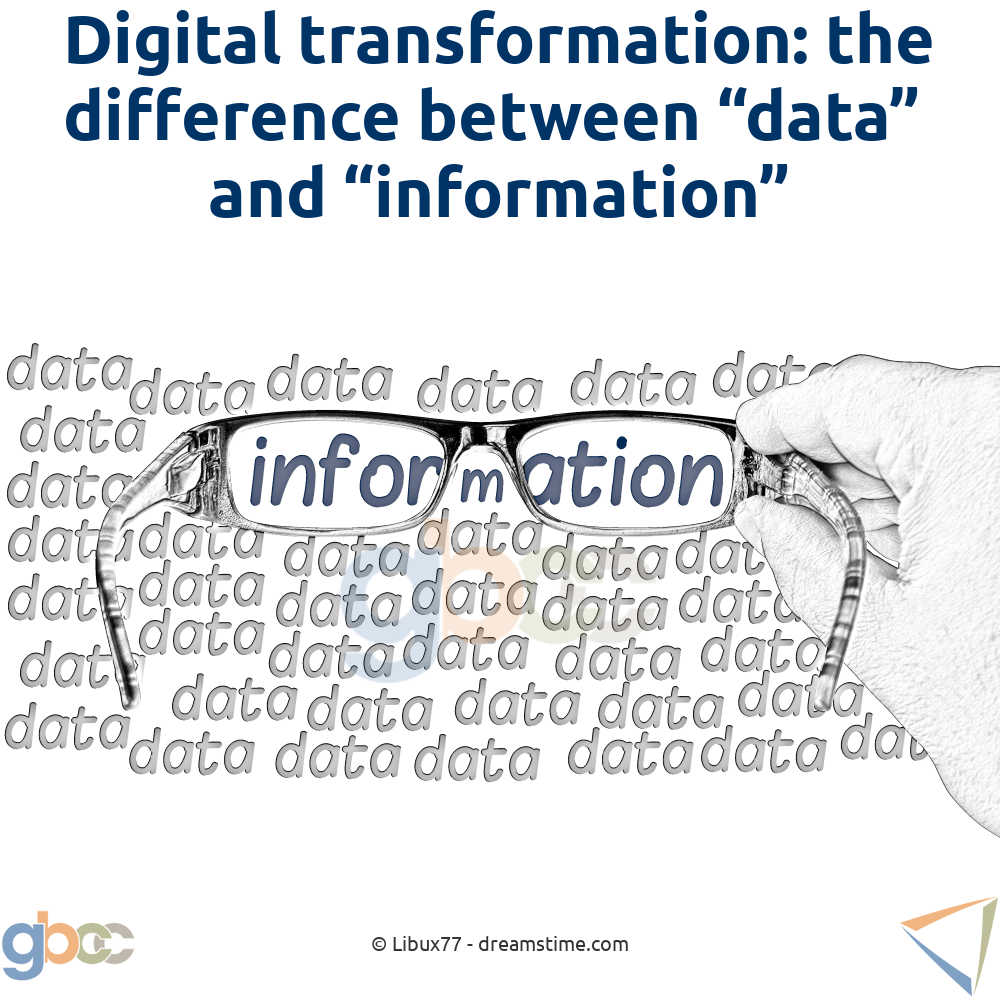Digital transformation places the “efficiency of data exchange” in the foreground and therefore displaces, to a certain extent, whether relevant information is actually exchanged and whether it is based on valid data.
The term “digital transformation” is on everyone’s lips. As a rule, it means moving data that is currently exchanged offline into a digital environment and exchanging it there instead.
To illustrate, person “A” fills out a form using their local computer, prints it out and sends it by post to the attention of person “B” at another location, who then manually records the collected data on their own local computer and uses it further. If person “C” is also needs to look at the form data, then “A” (or “B”) will copy the form and send the copy to “C”. If the form contains data, like an address that “B” needs for a letter, then “B” sits down and types the address into the letter address field manually.
A digital transformation will replace the process as follows: the form fields that are filled in by “A” on a cloud-based software or platform using a local computer. It is then available in digital form via interfaces accessible not only to “B” and “C”, but also to all other future authorised persons. And the data entered in the form fields can be processed automatically and without errors (e.g., for sending a letter).
The “context” turns data into information
Whether offline or online, the form fields contain data. Now, imagine that a field without a field name states “Johnnie Walker”, nothing else. Does this refer to the name of an individual? Or is it the name of a whiskey brand? Perhaps something entirely different?
If “B” is provided with this context, then the data “Johnnie” + “Walker” becomes information. Whether this information is then relevant for “B” is another matter entirely.
In my opinion, this brings us to one of the blind spots of the digital transformation. When someone (manually) designs a form, then the “relevance of the information” is the main focus because the form is usually created for the needs of the person who needs the information. And they probably know what data they would need to collect to have the relevant information they require.
The process is we know what information we need and collect data for it.
Digital transformation: will the tail wag the dog afterwards?
Digitalisation projects, on the other hand, develop their own logic and momentum. Its motto is let’s collect and report as much data as possible through machine. In doing so, we will have worked efficiently and will have peace of mind because everyone can extract the relevant data they need for themselves.
Now, the process is we collect data and then see if and what information we could extract from it.
That may sound good and it’s probably well-intentioned, but well intended is not always well done.
As an aside, we are not talking about “big data” here. We are talking about data generated from an ordinary SME’s day-to-day business, which is then compiled in large databases and made available to the company’s skilled employees.
The name of the module (e.g., “Orders”) together with the row and column names (e.g., “Customer No.” and “Date”) provide some basic contextual information.
But the way they are presented as a large collection of data means only a trained observer with an affinity for numbers and tables can extract the “relevant information” from them.

This task should – theoretically at least – be taken over by the stored reports, which all common software programmes provide as standard functionality. In reports, information is aggregated, grouped, and sorted.
It will probably surprise you to learn, from my experience, how rarely employees engage with reports and the information they contain of their own accord. Why is that? Why is it that skilled employees do not see this information as relevant to their work, and therefore do not proactively look at it? This leads to the crux of the matter!
Obstacle 1: the hierarchical organisational structure
The first possible track leads to the organisational structure. The “relevant” information is determined “from above on behalf of below”. Here’s an example from my own experience:
Back then, as a key account manager (KAM) in corporations with a matrix-structured organisation, I was responsible for the worldwide business with my international key customers. No one ever asked me what information I would like to have. Instead, I was presented with the following information by default:
- My total turnover compared to the previous period – The “development of total turnover” information was relevant for my reporting line. A further breakdown by an account manager was needed for my direct supervisor to assess my performance. For me, this information became a little more relevant due to the further contextual information from points two and three below.
- Breakdown of turnover by product group and by region – This information was relevant for the respective product and regional managers.
- Breakdown of turnover by customer –
Further reading:
„Is a turnover increase and growth intrinsically positive?!“.
Entrepreneurship without a turnover increase and growth is unthinkable, But the usual information are useless and the right information are missing!
This information would have been really relevant for me if the data provided the answer to this question: “Why did this development occur?” Was my turnover down because…
- … we were too expensive?
- … the competitor’s product was better?
- … there was a shift in customer demand?
- … ?
Since the relevance of the information was paramount for me, I was prepared and normally obtained the information “manually” long before I received the report. If there was a surprise development, I obtained the relevant information afterwards. For example, by asking my customers about it. And here we come full circle and arrive at the blind spot of the digital transformation that we discussed earlier.
The digital transformation puts the efficiency of data exchange in the foreground and thus displaces the question of relevance to a certain extent.
Suddenly, it no longer feels coherent to “get the information manually afterwards”. You let it go and settle for the information that has been efficiently determined by machine and is available.
Obstacle 2: lack of a process mindset
Real activities in companies take place in process steps. What one person produces as output is needed elsewhere as input by another person. The “internal supplier/service provider” meets the “internal customer”. How useful is this colleague’s output for my work? How error-prone is the output? How long do I have to wait for their output? These are questions that are very relevant.

However, the interests of one’s own department diverts the individual’s attention away from the processes.
Instead of worrying about what our internal customer needs from us, we worry more about what our boss thinks of us.
And the boss’s attention is focused on _what_ he wants us to do in that department, not on what that activity will do for other departments.
You can check this yourself when the next opportunity arises. For example, ask a skilled colleague who has opened an input mask and is writing in data:
- “Why did you fill in field X? Who gets this information?”
- “Why did you leave field Z blank? Who would benefit if the information was available?”
You won’t get a useful answer, most likely because this information was never made available to this skilled person.
And this is precisely why expensively purchased ERP systems gradually degenerate into dusty digital filing cabinets.
To take up my own example from above as a KAM, it was no different for me. Now and then, the employer presented us with a new CRM solution, and we were asked to store this and that information – quite time-consuming – in the system. However, no one explained to us the relevance of this extra work. Only that it was “insanely important” that we do it. For us, the activity was therefore completely unproductive and a waste of our valuable time, and we naturally stopped storing information as soon as they stopped monitoring the process.
How valid is the data on which the information is based?
As far as the digital transformation is concerned, there is another problem that needs to be addressed:
how can you actually tell that “the right thing” has been measured? How can you tell that the right thing has been measured “correctly”? How can you tell that what was measured correctly was recorded without error?
Back then, as a KAM, this was a real problem. The information I received was practically never correct. This is because the aggregated data of a client’s group of companies consists of many variables that must be taken into account during the data collection process. For example, was the associated client company inadvertently registered as a subsidiary of a client group? Currency of revenue correctly recorded? Transitory items correctly recorded? And much more.
All these variables were controlled by input keys that the person responsible for the data has to consciously set. The problem that comes along with this is the activity of capturing data looks easy and is therefore assigned to cheap and inexperienced assistants. However, being able to look at data critically to enter it correctly often requires in-depth knowledge and a multi-layered experience.
Having said this, my sobering realisation is:
The question of who, and how exactly, has ensured that data are valid does not really seem to interest anyone.
And here we have come full circle again and are back to the previously discussed blind spot of the digital transformation.
Because the digital transformation, as mentioned before, focuses on the efficiency of the data exchange, it also displaces the question of the data’s validity to a certain extent. It does not feel coherent to check the validity manually afterwards. One leaves it alone (while keeping one’s fingers crossed).
What’s worse is the employees are literally trained not to think for themselves. To use the example from the beginning, if person “B”, when manually typing the recipient’s details into the letter, notices that there is no data in the salutation field, then they simply add the missing information (e.g., “Dear Mr Walker”). An attentive person will even take the precaution of checking whether a title is also missing.
But not after the “successful” completion of the digital transformation! Because afterwards, everyone will act as if it is the most normal thing in the world that the letter salutation reads “Dear Walker” due to the missing information.
Conclusion:
In my opinion, a successful digital transformation is achieved:
- If people have previously communicated successfully with each other and agreed on who needs what relevant information, including when, how, and from whom in the work processes, in order to be able to do their job properly.
- This information is then available to the person “at the touch of a button”.
- And the person can also rely on the fact that the information received is based on valid data.

